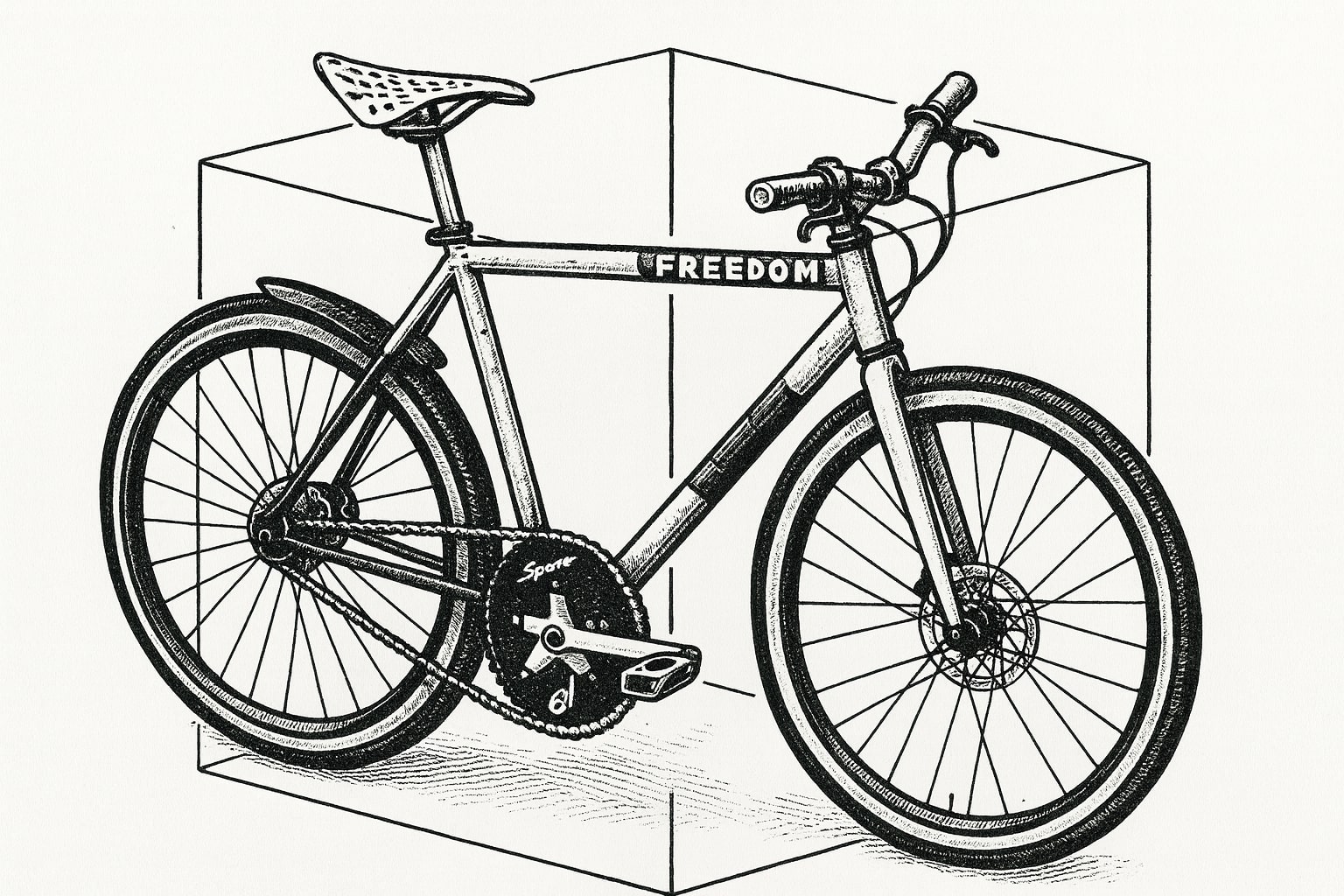60×13
1. Origin
A bike that is more than a bicycle. Die Machine – half singlespeed, half track bike, half BMX, and half TT missile. A Frankenbike, born from an obsession with massive gearing and the search for a training device that knows no mercy.
60 teeth in the front, 13 in the back, built onto a aluminium frame as stiff as an engine block. Whoever pedals here is not shifting gears – whoever pedals here fights physics.
2. The Leap
The numbers are absurd.
With 40×13, the limit was reached at 40 km/h – at 120 rpm cadence. With 60×13, the dimensions shift.
Every crank rotation moves the bike almost ten meters. At 90 rpm, speed climbs past 50 km/h. The difference is not linear, it is brutal: a leap that turns cycling into a form of mechanical weightlifting.
3. Numbers in Motion
The calculation is simple, the outcome is not:
| Gear | Development per rev | 90 rpm | 120 rpm |
|---|---|---|---|
| 40×13 | ~6.48 m | 35 km/h | 47 km/h |
| 60×13 | ~9.72 m | 52 km/h | 69 km/h |
Each added tooth is not just speed, it’s another demand for raw power.
4. Power and Resistance
Power is not calculated in the head, but in resistance. With a system weight of 95 kg and an upright MTB position, air drag grows exponentially. On 40×13, about 400 watts were enough to hold 40 km/h. On 60×13 at 50 km/h, the demand climbs toward 700 watts. At 60 km/h it scrapes 1,100 watts, and at 70 km/h it breaks 1,600 – numbers most track sprinters only see in split seconds.
5. Gradient as Test
Climbing tells its own story. On a 14% slope, Die Machine asks for more than lungs. The formula is:
F=m⋅g⋅sin(θ)F = m \cdot g \cdot \sin(\theta)
95 kg, 9.81 m/s², 14% → about 130 N on the pedal. With a 170 mm crank arm, that means 22 Nm torque, multiplied by the gear ratio. The outcome: each stroke equals over 130 kg pressing down through a single leg. Not cycling, but deadlifting in motion.

6. Ride Character
The ride feel changes radically. 40×13 could be pedaled “round,” in the classical sense. 60×13 dictates a different movement: stamping, pressing, pistons up and down. Cadence becomes secondary. 30, 40, maybe 60 rpm – no elegance, just raw mechanics. Every stroke a rep, every kilometer a set.
7. Cadence Log
The speed table reads more like a lab log than a training plan:
| Cadence | Speed (60×13) |
|---|---|
| 30 rpm | 17 km/h |
| 60 rpm | 35 km/h |
| 90 rpm | 52 km/h |
| 120 rpm | 69 km/h |
Each number is a challenge, each line another opponent.
8. Why Do This?
Die Machine is not an efficiency project. It is too heavy, too unforgiving, too absurdly geared to make rational sense. And yet, that is its purpose: it shifts training logic. It does not just build aerobic capacity or lactate tolerance – it builds something rarer: uncompromising muscular endurance.
9. Tour de Bière
In preparation for the Tour de Bière, Die Machine finds its mission. Jičín means 70 kilometers with 1,600 meters of climbing, ramps up to 14 percent, ridden on coaster-brake bikes with no gears. There, where gearing gives no mercy, tactics do not count. What counts is the willingness to push a slope with nothing but raw force. Die Machine simulates exactly that moment – on the flats, in daily life, without mountains.
10. Effects
The effects do not show up in watt numbers, but in the body. Within weeks, the reserves normally hidden in fast cadence vanish, replaced by another kind of stability. The sense of carrying load longer, the upper body locked, the legs working like pistons. Heart rate and breathing follow, but it is the muscle that does the real labor. Where others fade, the pressure remains.
11. Training Plan
A training plan with Die Machine looks nothing like one with a road bike. No interval charts, no zones. Instead: fixed distances, fixed gears, defined ramps. Two to three sessions a week of 60 to 90 minutes, cadence rarely above 50, but constant heavy load. Longer rides on a normal bike keep agility and economy alive. Die Machine is not a daily tool – it is a blade, used only when the cut is needed.
12. Everyday Use
But Die Machine is not confined to the lab. It rides daily to work: two times a handful of kilometers along the path. A section that could be routine becomes training. The commute transforms into two sets of strength endurance, morning and evening. No warm-up, no cool-down – resistance is there from the first pedal stroke.
13. Naming
Die Machine is layered. “Mach” points to the Mach number: to be determined – because speed here is never fixed, only fought for. Or, as Friedrich Liechtenstein and Purple Disco Machine put it: “Sie ist die Maschine, die niemals müde wird”.
That is the true parallel – a bike that does not ask for efficiency, but for the willingness to confront physics over and over again.
14. Closing Point
Haiku
Steel teeth bite forward,
railway path at dawn in mist,
weight becomes breathing.

